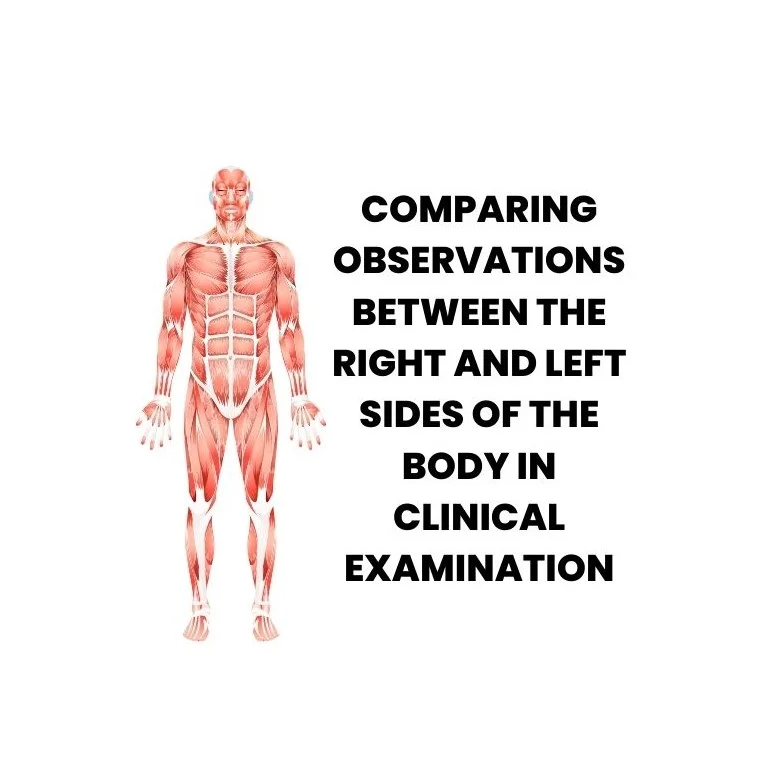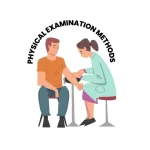Comparing observations between the right and left sides of the body during clinical examination is a fundamental practice in healthcare.
This comprehensive discussion explores in detail the numerous benefits of this approach, emphasizing its significance in accurate diagnosis and effective patient care.
Through thorough analysis and illustrative examples, we will delve into why this practice is crucial in clinical assessment.

Table of Contents
ToggleIDENTIFICATION OF ASYMMETRY
Explanation:
Comparing observations between the right and left sides of the body serves as an initial step in identifying any asymmetry or irregularities.
Human bodies are naturally symmetrical, with corresponding structures and functions on both sides. Deviations from this symmetry can indicate underlying health issues.
Example:
A physician examining a patient’s face may notice that one side of their mouth droops slightly, while the other remains level.
This observation suggests facial nerve dysfunction, a condition that requires further evaluation. Identifying this asymmetry is the first step in diagnosing conditions like Bell’s palsy.
DETECTION OF LOCALIZED ABNORMALITIES
Explanation:
Localized abnormalities, such as lumps, lesions, or swelling, can often be better detected when observations are made bilaterally.
Comparing one side to the other can highlight subtle differences that might otherwise go unnoticed.
Example:
During a breast examination, a healthcare provider compares the right breast to the left.
They notice a palpable lump in the right breast that is not present in the left.
This finding raises suspicion of breast cancer, leading to further diagnostic tests like mammography and biopsy.
ASSESSMENT OF RANGE OF MOTION
Explanation:
Assessing the range of motion of joints and limbs on both sides of the body is essential for identifying musculoskeletal issues.
Comparing one side to the other helps pinpoint limitations, stiffness, or abnormalities.
Example:
When evaluating a patient’s shoulder mobility, a physiotherapist asks the patient to perform specific movements on both sides.
If the patient can raise their left arm above their head comfortably but experiences pain and restricted motion in the right arm, this suggests a potential shoulder injury or condition that needs targeted treatment.
IDENTIFICATION OF STRENGTH IMBALANCES
Explanation:
Strength imbalances between the right and left sides of the body can reveal underlying neuromuscular or orthopaedic conditions.
Comparing the strength of corresponding muscle groups helps identify weaknesses or discrepancies.
Example:
A physical therapist working with an athlete asks them to perform leg lifts on both sides.
The athlete struggles to lift their right leg as high as their left leg and experiences discomfort.
This finding may indicate muscle imbalances or a possible injury that requires rehabilitation.
RECOGNITION OF SENSORY DEFICITS
Explanation:
Comparing sensory responses on both sides of the body is crucial for detecting sensory deficits, such as numbness, tingling, or loss of sensation. This assessment aids in identifying neurological issues.
Example:
A neurologist conducts a sensory examination on a patient with suspected peripheral neuropathy.
They use a soft brush to stimulate the skin on various areas of the body.
The patient reports reduced sensitivity to the brush on their right leg compared to their left.
This discrepancy highlights a sensory deficit that requires further investigation.
EVALUATION OF REFLEXES
Explanation:
Assessing reflexes, such as the deep tendon reflexes (e.g., knee jerk reflex), on both sides of the body is essential for diagnosing neurological conditions and spinal cord injuries.
Example:
A physician tests the patellar reflex on a patient by tapping their right and left knee tendons.
While the left knee jerks in response to the tap, the right knee exhibits no reflex.
This finding could indicate a neurological issue or spinal cord injury affecting the right leg.
ASSESSMENT OF CIRCULATORY FUNCTION
Explanation:
Comparing vascular function between the right and left sides of the body is vital for diagnosing circulatory disorders, such as peripheral artery disease (PAD) or deep vein thrombosis (DVT). Differences in pulses, temperature, or skin colour can signal circulatory issues.
Example:
A nurse assessing a patient’s lower limbs notes that the right foot is cooler to the touch than the left and has weaker pulses.
This observation raises suspicion of reduced blood flow in the right leg, prompting further evaluation for PAD.
EARLY DETECTION OF PATHOLOGICAL CHANGES
Explanation:
Pathological changes, such as skin lesions, moles, or wounds, can be identified early when observations are made bilaterally.
Comparing one side to the other helps detect changes over time.
Example:
A dermatologist examines a patient’s skin for signs of melanoma.
By comparing the right and left sides of the body, they notice that a mole on the patient’s right arm has changed in size, shape, and colour compared to a similar mole on the left arm.
This early detection prompts a biopsy and timely intervention.
MONITORING PROGRESS AND TREATMENT EFFICACY
Explanation:
Comparing observations between the right and left sides of the body is crucial for monitoring a patient’s progress during treatment.
It helps healthcare providers assess the effectiveness of interventions and make necessary adjustments.
Example:
A physical therapist is treating a patient recovering from a stroke.
By comparing the strength and range of motion in the patient’s affected (right) arm to the unaffected (left) arm over several weeks, they can track improvements and modify the rehabilitation plan accordingly.
ENHANCED SYMPTOM LOCALIZATION
Explanation:
Symptoms experienced by patients can often be vague or non-specific.
Comparing observations on both sides of the body aids in localizing the source of symptoms, guiding further diagnostic investigations.
Example:
A patient presents with lower back pain that radiates down one leg.
By comparing the right and left sides, a physician may notice muscle weakness and reduced reflexes on the right side.
This suggests that the pain originates from a specific nerve root compression, leading to a targeted lumbar spine MRI for confirmation.
FAQs:
Q1: Is comparing observations between sides relevant in all medical specialties?
- Yes, the practice of comparing observations between sides is relevant across various medical specialties. It aids in accurate diagnosis and patient care in fields ranging from neurology to dermatology.
Q2: Can comparing observations detect subtle changes that might go unnoticed otherwise?
- Absolutely. Comparing observations can highlight subtle differences, such as localized abnormalities or sensory deficits, that might be easily overlooked when examining one side alone.
Q3: How can patients benefit from the early detection of pathological changes through bilateral observations?
- Early detection of changes like skin lesions or moles can lead to timely intervention and better treatment outcomes. Patients can receive prompt care and potentially prevent the progression of diseases like skin cancer.
Q4: Are there situations where comparing observations is not necessary?
- Comparing observations is a standard practice in clinical examination. While there may be situations where it seems unnecessary, it serves as a fundamental step in ensuring comprehensive patient assessment and accurate diagnosis.
CONCLUSION
Comparing observations between the right and left sides of the body is a fundamental practice in clinical examination.
Its benefits extend across various medical specialties, aiding in the identification of asymmetry, detection of localized abnormalities, assessment of range of motion, recognition of strength imbalances, and more.
By systematically comparing observations, healthcare providers can enhance diagnostic accuracy, optimize treatment plans, and improve patient outcomes.
This practice is an indispensable tool in the arsenal of healthcare professionals, ensuring that patients receive the most comprehensive and effective care possible.













Leave a Reply